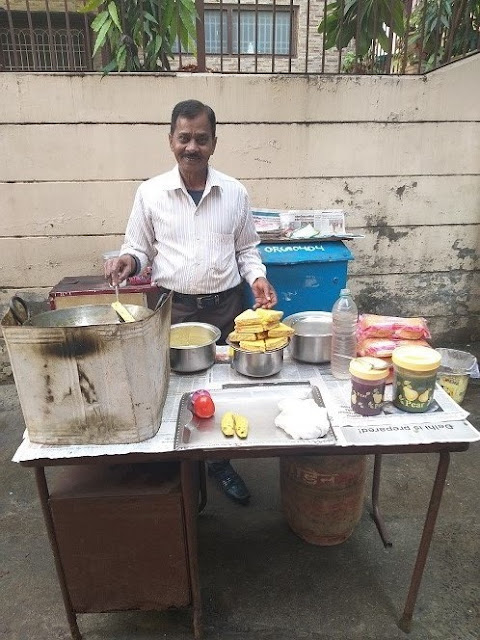
With ancestral origins in Sukkur Sindh, Ada’s family shifted first to Lucknow where he was born and then shifted to Delhi some 35 years ago.
Milind Teckchandani
Whilst I live in a relatively Sindhi neighborhood of Rajinder Nagar in Delhi, however lingua franca of daily conversation is usually Hindi. One of the few exceptions to this is when I meet Ada Ram. “Ada” in colloquial Sindhi is used to address an elder brother. Saeen Ram runs a small Indian Snack shop (Bread Pakoras/ Tikkis) from a temporary kitchen about 50 meters from my home. He sets his stall at around 4 o clock in the evening and is available till the stock lasts. His is a one man show – he prepares around 20/25 Bread Pakoras and a similar number of Tikkis each day and is popular with the local residents for serving homely made, fresh, crispy Bread Pakodas and ” Channe Ki Dal” filled Tikkis with fresh Mint and Saunth Chutney. With ancestral origins in Sukkur Sindh, Ada’s family shifted first to Lucknow where he was born and then shifted to Delhi some 35 years ago, having originally come to stay with an elderly relative in Azad Market and subsequently shifted to Rajinder Nagar. The elderly relative died a decade or so ago but Ada still stays here and continues to run the kitchen. Mummy tells me that “Channe ki Dal” filled Tikkis are quintessential Sindhi. Ada’s Bread Pakoda and Tikkis are highly in demand at my home whenever we have a family gathering with elderly relatives usually commenting ” Ghar jaedi tikkiyun thaaendo aa” (He prepares Tikkis similar to what we have at home). We all appreciate his culinary skills. In keeping with changing times and the young student population in Rajinder Nagar, he now also sells Burger (using his Tikki as the filling; you can see peeled onion and tomato in the tray below). It reminds me of how mummy used to pack both Tina and me burgers when we used to go on school picnic during our primary school days (!). Ada Ram like hundreds of others Sindhi reflect the community’s ethos of hard work and dedication without relying on external support to make ends meet.
On another note, Papad (Papadum/Popadum as they say in the west) is an integral part of meal in a Sindhi household. Whether it is the Roasted papad along with Sai Bhaji and Bhuggal Chawal , or it is the fried ones with Alloo ki Poori, this delectable snack is a staple in every Sindhi household. The other day with our stock of Papad coming to an end, Mummy asked me to buy a kilo from the lady who comes at our local community centre, Sindhu Samaj, on most Saturdays and Sundays. Not only does she sells Papad but also Chakkriyun, Kheechas, Khatan (Pickle) and Peppermint among other things. I wasn’t aware that a number of elderly people prefer eating Peppermint candies for its digestive benefits. It is on that day that I realized that buying Papads is not as easy as it seems. I had to call mummy a couple of times as there are a number of variants each with their peculiarities – some are spicier than others, some with differing sizes and bigger than others, and so one. The lady told me that Gwalior (in Madhya Pradesh) and Ulhasnagar (in Maharashtra) are the two major cities where a number of Sindhi families are engaged in this business. Sindhi papads are different from the Rajasthani/Marwari ones as those are smaller and much less crispier than ours. Some of the more known brands include MAHALAXMI and SAI BABA which I assume is a brand named after Shirdi Sai Baba who have a strong following within the community.
_____________________
Courtesy: Sindhi Chokro Blogs (Published on March 22, 2020)